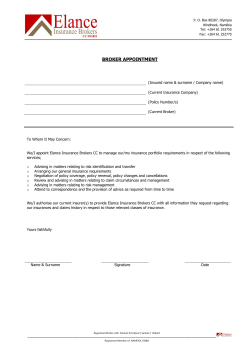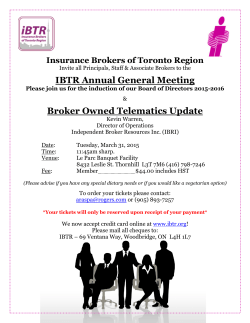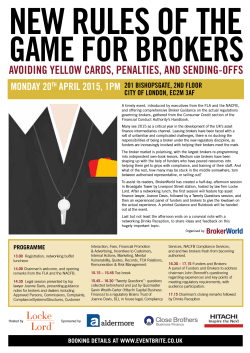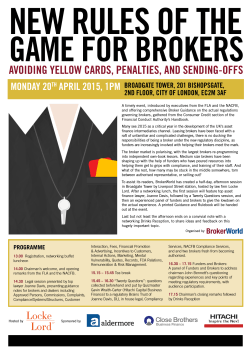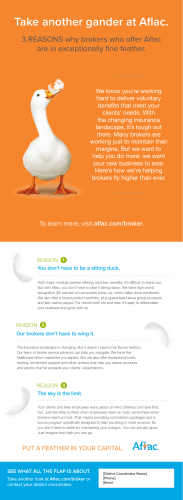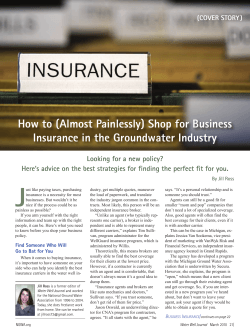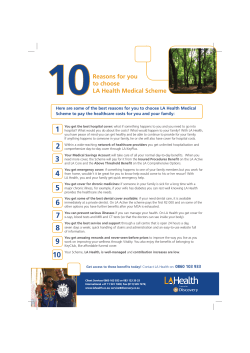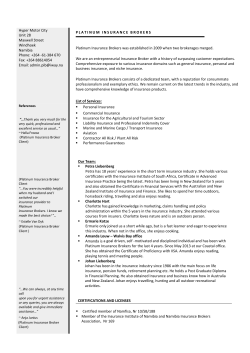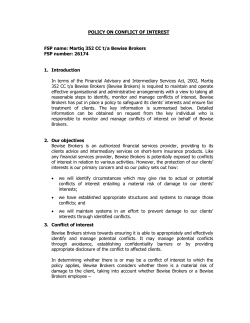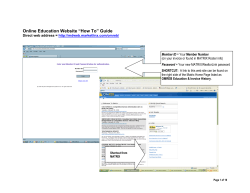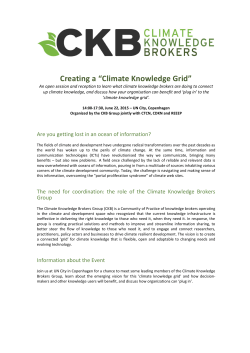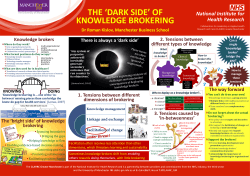
How to Be More Than Just Another Broker by Michael R. Ocilka
Standing out in a Cluttered Marketplace: How to Be More Than Just Another Broker by Michael R. Ocilka Director of Marketing PT Marketing Group Pittsburgh, PA 12 • N O V E M B E R 2 0 0 4 HIU Employee benefits decision makers are bombarded by brokers and consultants who all claim the same thing—that they can offer better products, provide more service and help control costs better than anyone else. Indeed, improvements in these areas are needed in many company-sponsored benefit plans. Years of consecutive double-digit rate increases have employers and employees frustrated and looking for solutions. But, according to industry studies, there is little relief in sight. In the meantime, employers need to maximize their returns on every health plan dollar spent, both in terms of the effectiveness of their benefit plans and in the service provided by their broker or consultants. Shopping Brokers, Not Carriers The practice of shopping for brokers rather than for carriers or health plans is a novel concept for some prospects. But the extent and impact of marketplace changes has obliged many buyers to challenge the status quo, resulting in an increased level of competition among brokers and consultants. This level is even more heightened by the realization that many employers are not receiving the service that they expect. HIU N O V E M B E R 2 0 0 4 • 13 At best, there are probably three or four major carriers in most markets throughout the country from which a client can choose. Therefore, brokers who can offer a menu of comprehensive and valued services, proactive solutions and timely responses to any issue best demonstrate their specific worth to clients. Three brokers with successful businesses and years of experience share the following bits of advice about how to stay close to your clients. “We probably have a 94% or better retention rate yearto-year,” says Richard Ramsburg, MBA, CSA, a senior account executive for EBD Financial in Herndon, VA. “It’s an ongoing challenge to keep everyone happy. But, as basic as it sounds, what you have to do is to stay in tune with your clients’ current and emerging business needs, as well as their overall strategic plans. If we do lose a client, it generally is a surprise to us, usually due to a merger or acquisition, clients going out of business, or some radical change in the business model or benefits program. If approached by other brokers, our clients tend to alert us. That’s exactly what happened in two recent instances and, in both cases, we were able to demonstrate and reaffirm our value and retain those clients.” Ramsburg emphasizes that it’s the “blocking and tackling” areas that are most important in keeping a client satisfied. Whether it’s proactive meetings throughout the year, The big deal is doing a discovery process of what your client really wants, what’s a monthly wellness newsletter, benefit surveys, carrier upworking and what’s not, and coming up with solutions. Everyone thinks that they’re dates, or designing and assistdoing that … but some do it better than others and that’s what makes the difference. ing in worthwhile and ongoing employee communications, all of this and more Let’s face it, no advice will be taken seriously and acted can ensure that clients are receiving the attention they upon unless the employer feels that his unique situation is need and deserve. truly understood. This is possible only when you truly are At least once a year, EBD Financial invites clients to an close to the client. offsite seminar to learn what’s new, with presentations focusing on two or three timely topics, followed by a casual ‘Just Understanding’ Isn’t Enough wine-and-cheese get-together. At a recent gathering, EBD’s Employers expect you to know and understand their clients heard presentations about absence management business, its culture, the workforce and the significant role and its impact on various facets of the company, received a that the health plan plays in an employee’s life. Only by HIPAA and COBRA compliance update, and heard an being close to the employer and the employees—by underoverview on HSAs. Those who attended found the session standing what aspects of the plan are important and why worthwhile and informative. Clients who couldn’t be there —can you determine what changes to consider and apprewere sent a complete summary of the proceedings. ciate the true impact that any changes may have. When changes are made, they require careful and proper rationWhat’s the Big Deal? ale, positioning, communicating and an ongoing analysis Getting the right people on the account right from the of the impact. The depth of this type of understanding beginning is how Randy Achenbach of Murray Insurance and action goes far beyond simply gathering a census, reAssociates in Lancaster, PA, stays close to his clients. “The viewing claims histories or the obligatory shopping for first decision you have to make, and probably the most rates at renewal. important, is who within your firm will be the best indiThat understanding must be combined with the realvidual to sell, service, and retain specific accounts,” he ization that there are three to four distinct groups within says. “The broker for a larger benefit client requires a difa company—owners, finance, HR and employees—each ferent skill set than someone who may be working with a with their own individual yet interdependent wants and case of 25 lives. You would think this is a fundamental needs. Make the lives of the people in each of these groups strategy but I don’t believe that it automatically happens in easier and you differentiate yourself from everyone else many of the regional or local brokerage agencies. Agencies vying for the business. that do not understand this will have difficulty retaining A survey conducted last year by Ross McManus, an Albany-based business analysis firm, determined that a sizeable number of company executives do not hold their consultants in high regard. More than 1,200 senior executives, representing more than 20% of the Fortune 1000 firms, indicated that consultants and professional service providers rated only a C+ grade for overall satisfaction. It’s probably safe to say that if some of the largest firms in the country are dissatisfied, the same sentiment holds true when it comes to brokers and consultants serving small and midsize markets. What do employers really want from a benefits consultant, beyond innovative ways to control spiraling health costs that transcend the immediate quick fixes of cost sharing and shifting? In the Ross McManus survey, 96% of the senior executives said that the ability of professional service providers and consultants to understand their business was their most important satisfaction characteristic, while not understanding their business was the number-one reason for terminating them. A 2003 phone survey conducted by the strategic consulting firm ChapterHouse likewise found that a majority (88%) of employers indicated that brokers had “significant influence” over their benefit decision. 14 • N O V E M B E R 2 0 0 4 HIU Cutting through the Clutter In more than 12 years of cutting through the clutter, reaching prospects and scheduling confirmed appointments, we have assisted hundreds of clients with prospecting. When we make the call, here are some of the points we emphasize: This is a win-win situation. Position an initial 30-minute meeting as strictly introductory, an opportunity to hear some innovative approaches and improve the current plan. Objections such as lack of time to meet, the strength of the relationship with the current broker and complacency may be overcome by positioning the meeting as a win-win situation for both parties. At the very least, they may hear that their current plan is being correctly handled, or they may find out that there really is room for improvement. Not all brokers are alike. Not all brokers offer the same quality and level of service, marketplace expertise and product knowledge.Today, every company needs to know about all available options.The meeting presents an opportunity to discuss the company’s health care environment, touch upon strategic plans for the future and other situations that the current broker should be looking into. Granted, there are some client/broker relationships that are extremely strong and cannot be shaken.You can only hope that your clients echo those sentiments when they are prospected by others. Just renewed? No problem. A better time to meet can actually be outside of the traditional review period. This is when one can take the time to explore what the marketplace has to offer and determine what options best address specific needs. There is no pressure to make decisions within a specific time frame and a thorough review and comparison can be done in a stress-free environment. This also fosters a better blueprint for long-range planning, rather than the implementation of quick fixes, which may turn out to be short-sighted. The full impact of strategies under consideration can be thoroughly evaluated and, if decided upon, a well-thought-out communication and education process can be developed. Besides, this is an initial meeting, an opportunity to find some common ground for proceeding in the direction of improving the plan. FYI, here’s something you might find of interest. It’s unrealistic to think that every objection to a meeting can be overcome during an initial contact. Therefore, it pays to stay in touch with a good prospect by periodically sending them worthwhile information—summarized news about industry happenings, new approaches to various plans, etc. By all means, know their renewal date and review period. Regardless of the sound rationale offered above, some decision-makers only want to deal with benefit issues when they absolutely have to. Be there when they reach that point. HIU N O V E M B E R 2 0 0 4 • 15 larger accounts simply because they may not have the right team assigned to that client. The differences in the skill sets is more than just understanding all of the available carrier options or appreciating the extent and detail of the decision-making process and the buy-in levels of everyone involved, he adds. Some people may think that, with only three carriers in the market, what’s the big deal? “The big deal,” he says, “is doing a discovery process of what your client really wants, what’s working and what’s not, and coming up with solutions that meet their needs and goals. Everyone thinks that they’re doing that, and many of them probably are. But some do it better than others and that’s what makes the difference.” After all, the same persistent, consistent and creative efforts that are made in acquiring a client are certainly needed to retain that client. What good is it if, while you’re bringing new clients in the front door, you’re losing existing ones out the back? So a good client retention strategy should be to always proceed as if both the ongoing benefit plan and the broker/client relationship are constantly under review. In the reality of today’s marketplace, they are. “Because of the nature of the marketplace, carrier turmoil and consistent and significant rate increases, brokers are having a more difficult time staying close to all of their clients,” notes Achenbach. “There is a considerable amount of pressure created by needing to get quotes for every account each year, and unfortunately some things fall through the cracks. But what’s most important is not just responding to your client’s situation, but rather anticipating what’s going to happen at the next renewal. Each account is requiring a lot more service than it did five years ago.” Not surprisingly, it’s the smaller companies that sometimes fall through those cracks. Achenbach has met with more than a few who had that deer-in-the-headlights look when he asked them how they complied with the new HIPAA requirements or if they’ve explored HSAs or other consumer-driven concepts. “It was apparent that their broker had not discussed anything about this with them,” says Achenbach. He adds, “These people are literally crying for information about what’s going on in the health care marketplace and how it relates to them. They are under severe financial pressure to handle rate increases and they want to know what their options are.” ‘I Let Them Use My Credit Card’ Olde Florida Benefits Group has been servicing clients in the Fort Myers area for more than 34 years and Vice President Matt Dinkel likes to think they go above and beyond as a matter of business practice. “You won’t get voicemail when you call our office; we answer our phones,” he says. “And I give my cell phone number out and tell my clients to use it; I’m available for them when they need help or have a question. If someone’s at the doctor’s office or in the ER at 2 a.m. and doesn’t have their card, they can call me and I’ll help them. It usually only takes a few minutes because I know what 16 • N O V E M B E R 2 0 0 4 HIU needs to be done; I do it every day. We take a hands-on, frontline approach to any problems when they arise.” Dinkel has actually gone so far as to give a provider his own credit card number for an employee’s payment. “I knew the coverage was there,” he says, “and I knew I would be reimbursed.” Staying close also means that every client receives a courtesy phone call bi-monthly to ensure that there are no unresolved issues or problems. Larger clients are seen in person. In addition, 60 days prior to renewal, Dinkel receives a census in order to market the group and have all viable options identified before the incumbent’s rates even arrive. Then he can come in as soon as the client receives the renewal and, if there are changes to be made, there’s ample time. By providing extensive, no-charge support for COBRA, Section 125, enrollment, claims, any ongoing administrative issues, and even individual employee billing reconciliation, Dinkel wants his clients to think of Olde Florida as an employee who they’ve hired for HR. After the renewal process, all the company has to really do is write the monthly checks; everything else is handled seamlessly or with a phone call to Dinkel or his staff. He estimates that assuming this role can save his clients five to six hours a week or more, allowing them to concentrate on their core responsibilities. Think only a large agency can do all that Olde Florida does for its clients? Olde Florida services more than 100 clients, ranging in size from 2 to 1500 employees…and they do it with four people. “We bring Fortune 500 service to smaller companies,” Dinkel says. “And, every once in awhile, we take time to remind them of that. What I discovered was that many employers didn’t even realize that employees were calling us directly or that so many of their HR functions were being outsourced; they just saw a smooth-working program. That’s good, but you also should make sure the client understands all of the value you provide.” At a time when many companies rank customer loyalty close to the bottom of the reasons-for-doing-businesswith-’em scale, these brokers say that most of their clients let them know when they are approached by or meet with other brokers. The reason: Even in the best relationships, some clients just want to get a different perspective or see if they are missing out on any information. Many of them will talk to anybody, but they won’t move for just anybody. Use some of the aforementioned tips to stay close to your clients and you may minimize the risk that they’ll switch. After all, it’s the capacity to provide what others don’t or won’t that is your key differentiator, the fundamental means to acquire and retain clients, and what is valued above all else. ■ Mike Ocilka is the director of marketing of PT Marketing Group, a telephone marketing and direct-marketing agency that specializes in sales support for the insurance and financial services industry. He can be reached at 800-999-8995, ext. 287, or mocilka @ptmarketing.com.
© Copyright 2025
